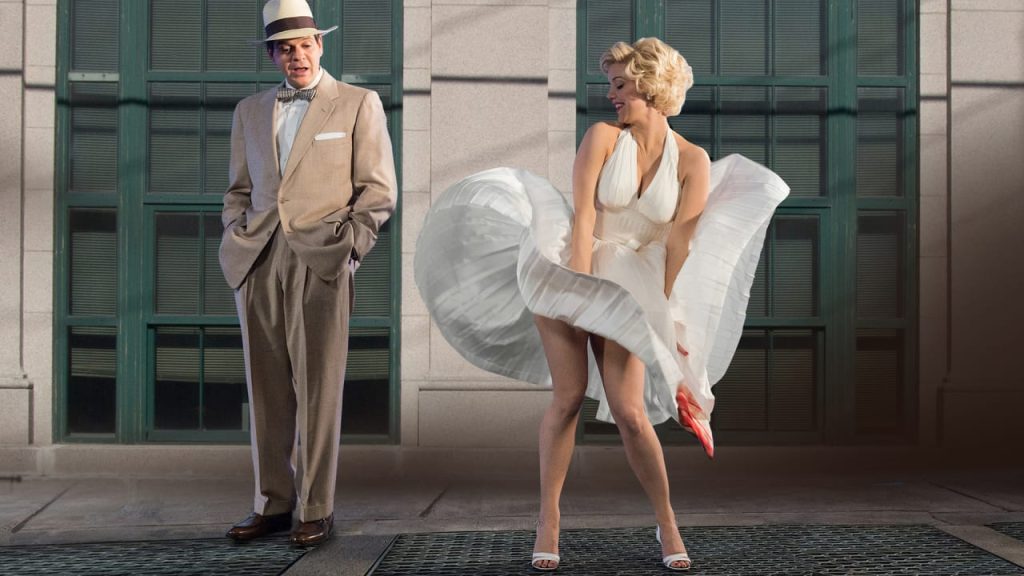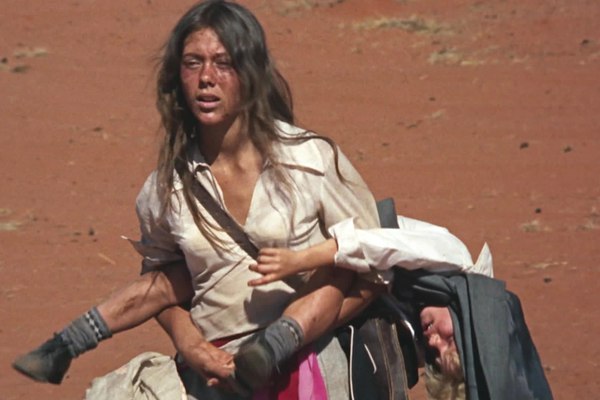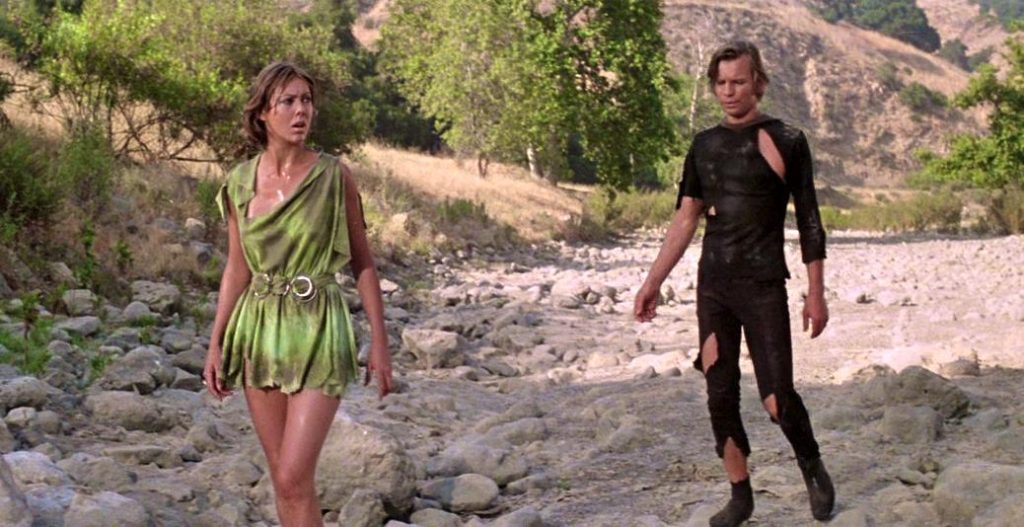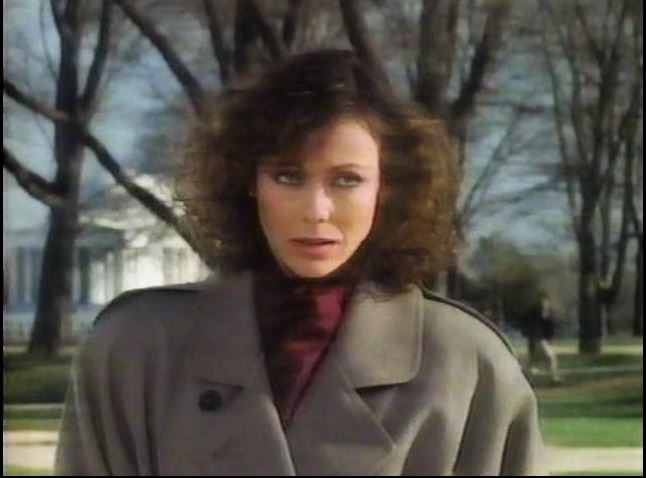So who’s your dream movie girl?
The one who gets your heart pumping?
The one so far removed from your mundane existence that if you’re honest you know you’re not worthy to share the same planet. In fact, you’re not even sure such a divine vixen is from Earth. Perhaps God lowered her from the heavens to give you an unobtainable glimpse of perfection for no other reason than he hates you and wants you to suffer.
Who knows?
But one thing’s sure: Throughout the ages generations of sad, lovelorn men have pined for a particular pin-up girl, some beguiling beauty they would not only respect and adore, but want to do really peculiar things with, like talk to deep into the night and maybe even raise children together. In the fifties such men often fixated on Marilyn Monroe atop a subway grate pushing down her billowing skirt. Before long they were trying to shove Bond out of the way in a bid to get at a wet, bikini-clad Ursula Andress rising from the surf. A little later the doe-eyed sexpot Susan George sauntered along. Femme fatale Kathleen Turner might have been next with her sensationally steamy debut while a magnetic Scarlett Johansson captivated endless hearts during her Tokyo sojourn.

Then again, maybe you’re a weirdo and always fancied a roll in the hay with the Wicked Witch of the West.
And me? Little ol’ me? Who was the one I most wanted to run hand in hand through a summer meadow toward a glorious setting sun before shyly asking if I could spank her?
Jenny.
Jenny Agutter.
Sure, there were the curves and a pleasing tendency to disrobe, but there was also that cute, upturned nose, the obvious intelligence behind those limpid green eyes, and the lilting, ever so posh voice. Seriously, no one enunciates like Jenny. That girl could dismiss me in person as an inadequate pustule who needs to stop objectifying women and start filing some accurate tax returns and it’d be pure bliss to hear my worthless name entangled within such beautiful diction.
And apart from that, she’s a very good actress who made three bloody terrific movies.

Girl in Walkabout (1971)
OK, so this is the one with a teenage Jenny in a school uniform wandering around the Outback. The same one in which she discards the aforementioned uniform and goes for a nude swim accompanied by a lush orchestral score.
O Lord, help me. Help me find the necessary restraint to keep my hot, blurred thoughts somewhere within the realms of decency and write something that won’t bring the cops rushing to my door.
Best forget that particular scene for now. I’ll just say it’s difficult to find a visually richer movie. Of course, director Nicolas Roeg had already provided some eye-catching cinematography on terrific movies like The Masque of Red Death, but the look of Walkabout really is a triumph. Filled with indelible images of an ancient landscape, it’s packed with scorpions, frilled lizards, red sand dunes, eagles, curious wombats, giant termite mounds, slithering snakes, playful cockatoos, bleached animal bones, Jenny in a school uniform.
Stop it, Dave. Just get a bloody grip.
Anyhow, it also has one of my favorite beginnings to a movie, a strange, essentially unexplained passage in which an uptight father takes his two children into the desert ostensibly for a picnic. One moment he’s checking some complex work notes and half-scolding his very young son for talking with his mouth full of candy, the next he’s trying to kill them at a distance with a pistol, a half-hearted escapade that simply results in him setting the car on fire and turning the gun on himself.
Jenny does exactly what you’d expect a somewhat perturbed schoolgirl to do and immediately leaves the burning vehicle and gets the hell out of there. For a while she amusingly tries to keep up a sense of normalcy, shielding her kid brother from the truth while telling him to take care of his blazer and not ruin his shoes.
“We don’t want people thinking we’re a couple of tramps,” she primly says, rather than doing her best to find food and shelter. But, of course, two rich, white softies are never gonna last long in such unforgiving terrain. At a rapidly drying waterhole, a teenage Aborigine (the ever reliable David Gulpilil) turns up and immediately shows the parched pair how to get water, leaving them no choice but to accompany him on his walkabout.
This is a movie that needs repeat viewings in a bid to grasp it all. It certainly doesn’t go the way you expect. Rather than despairing at their life-threatening predicament, both the relentlessly polite Jenny and her amazingly agreeable brother seem to adapt well, frequently appearing to be at one with nature. Racism never rears its ugly head. There’s even an odd humorous interlude involving a bunch of lecherous meteorologists, which underlines what an idiosyncratic filmmaker Roeg is. He utilizes a style that includes still photography, time jumps and reversals while flicking through some scenes as if newspaper pages are being turned. What’s more none of the characters have any names so you can come up with whatever interpretation you like, but there’s most probably some Garden of Eden stuff going on.
There’s also a constant play on the similarities and contrasts between Outback and city life. Didgeridoo music accompanies shots of busy streets. Rock faces are compared to brick walls. Kangaroos are graphically clubbed while a High Street butcher chops up meat with a cleaver. And although we like to think we’re more civilized and clever than spear-chucking darkies who plod around in the burning sun with fly-infested lizards tied to their midriffs, we’re the ones trying to murder our children. We’re the ones who have no clue how to live off the land. We’re the ones who’ve lost touch with something intangible yet vital.
Furthermore, our cruelties are woven throughout, sometimes in the most subtle ways, such as a cookery show radio presenter casually giving details of a gourmet delicacy that includes keeping a young bird in a light-deprived box until it’s old enough to be drowned in cognac.
About the only thing that’s predictable in this masterpiece is our Aboriginal hero finally grasping Jenny’s as cute as a button. Can’t blame the guy for having a go, but wooing a girl by daubing yourself with white paint, sticking feathers in your hair and doing a wide-eyed jerky dance is never going to end well. And how do I know? I once tried the very same thing at a school disco with the pig-tailed, off-limits Tracey Sharpe. Took years to live that one down.
Anyhow, Walkabout works as a beautiful mood piece, an unsentimental coming of age drama, an allegorical puzzle, and an unorthodox piece of cinema without any pretentious overtones. More than half a century later, its reputation remains undimmed. It really is lightning in a bottle stuff.
Oh yeah, and if you ever get badly sunburned, try smearing on some cooked kangaroo guts.

Jessica-6 in Logan’s Run (1976)
Amusingly lampooned by that freebasing horn dog Richard Pryor for presenting a future dystopia entirely devoid of blacks, the sci-fi cult favorite Logan’s Run is most definitely not without its faults. It’s campy, very much a movie of two halves, and suffers from a lazy, Dr Who-style ending in which an all-powerful computer blows up simply because it doesn’t like the answers it’s given.
On the plus side, Jenny is skimpily dressed throughout and goes for another nudey swim.
Set in 2274, Run begins with a bang as we witness the dramatic spectacle of Carrousel, a rejuvenating process everyone must undergo upon reaching thirty. White cloaked figures enter a revolving arena in front of a wildly cheering crowd as a calm female voice intones: “Be strong and you will be renewed.” They then magically levitate before being shot by a laser from a giant crystal. It’s quite obviously ritualized murder on a grand scale, but the city’s inhabitants have long been brainwashed into thinking they will immediately be reborn as babies.
State cop Francis-7 (Richard Jordan), a vaguely sadistic bully who’s employed to hunt down and kill anyone who tries to skip their big day, is all for Carrousel. “Keeps everything in balance,” he tells best mate and colleague Logan-5 (Michael York). “One is terminated, one is reborn. Simple, logical, perfect.”
This is a convincing setup as well as a concise explanation for how controlling, essentially evil societies can slither into being and continue to function. The first hour presents a well-realized, youth-obsessed world. Life is hedonistic, dominated by technology, and lived entirely within the city’s great domes. Not sure about all those escalators, though.
However, Logan’s cushy existence of state-sanctioned murder begins to unravel after beaming Jessica-6 into his living room for a bit of uncomplicated nookie. For a start she won’t bang him despite turning up nearly naked. And while nursing a prime set of blue balls his life clock’s fast forwarded and he’s given a worrying mission to find and destroy Sanctuary, a place outside the city where all those who’ve fled Carrousel allegedly end up.
There’s so much to love here, especially the colorful, well-designed sets, Jerry Goldsmith’s great score, the cool handguns that cause a ball of fire to erupt on their target, the automated flying cleaners that spray acid onto newly terminated Runners, the convincing deterioration of Logan and Francis’ friendship, the memorably mad, seven-foot tall Box who’s obviously some bloke encased in shiny silver cardboard standing on a skateboard, and the younger cast members who look like they’re limbering up to appear in the next Pat Benatar video.
Sadly director Michael Anderson drops the ball when a catfight between Jenny and Farrah Fawcett lasts less than two seconds, surely depriving 70s cinema of one of its greatest scenes in which they roll around tearing each other’s clothes off. The pace also flags following the city exit where the running pair is sappily won over by the old-fashioned ramblings of an aging Peter Ustinov, who plays his part with a full range of tics like a chubby, pussy-obsessed Rain Man.
Still, there’s a fair bit of thought-provoking meat in this tasty sandwich. Walkabout perhaps illustrated a biblical story, but I see Run more as a religious allegory highlighting the dangers of blindly accepting ingrained beliefs. Sanctuary is a stand-in for heaven, people are happy to kill to protect the most ridiculous lies and⦠Hey, did I tell you at one point a lizard runs up Jenny’s lovely thigh and disappears under her mini-skirt?

Alex Price in An American Werewolf in London (1981)
First seen in a crisp white uniform opening a hospital room blinds, Alex Price is so wholesome and delectable throughout this horror classic that you’re unlikely to ever encounter a more idealized version of a nurse. This is a relentlessly compassionate caregiver. She’ll cut up your food and slip appetizing morsels into your mouth. She’ll sit alongside and read to you. She’s good with kids. She won’t arrange for you to be lobotomized like certain other nurses. And after you’ve been discharged, she’ll invite you into her warm bed, not even minding too much if you end up sprouting hair and fangs and slaughtering a whole bunch of people.
Christ, if you took a girl like this home to meet the folks they’d be offering to pay for a full-blown church wedding and month-long Caribbean honeymoon before the evening was out.
David Naughton is the lucky bastard on the end of her tender care after surviving an attack by a lycanthrope on the Yorkshire moors. Three weeks later he wakes up in a London hospital to be told his best mate is toast, an escaped lunatic was to blame, and there’s nothing more to be done. Well, who cares about such frivolities when Jenny’s at your bedside attending to your every whim? As a doctor tells him: “Nurse Price will see to all your needs.”
Too bloody right.
You can even tell the exact moment Naughton gets smitten. He wakes up in bed and secretly watches her stretch like some super sexy kitten with breasts and no fur. Before long she’s taken him back to her apartment. A steamy shower follows, allowing him to lather the small of her back in the shower as she nibbles his shoulder.
And of course that’s me in there with her. Every single time.

(Well, why bother with reality when fantasy is always so much more comforting? For the record I once had to go into a British hospital when my waterworks went wrong. Did I get to meet the equivalent of Nurse Price and bask in her saintly care? Did I fuck. But I can recall awkwardly lowering myself into a bath to soak off the bloodied dressings only for a stout, middle-aged nurse to barge in, stare between my legs and grunt in a vaguely contemptuous way: “Urgh! That looks sore.”)
Anyhow, American Werewolf is undoubtedly one of the great horror comedies, a Limey love letter that contains an extraordinary number of things aside from Jenny to recommend it. The mood is perfectly set by the opening shots of the chilly moors as the melancholy bars of Blue Moon spring up. Then there are the whacked-out regulars at The Slaughtered Lamb (“You made me miss”), some great jump out of your seat moments, and a startling transformation scene that remains the wolf’s bollocks. Not to mention a naked man running around London Zoo stealing balloons and a bunch of whiney undead in a porno theatre.
Still, it’s a little strange how a Yank like John Landis managed to make such a quintessentially English movie. This is a flick full of red telephone boxes, ridiculously polite, arrest-averse Bobbies on the beat, eccentric folk in centuries-old rural pubs, and businessmen with clipped accents carrying briefcases and furled umbrellas. Not to mention the shots of iconic landmarks like Tower Bridge, scenes set on the London Underground, and plentiful jokes about the crud weather, the Royal Family and tabloid newspapers.
And, of course, radiant at the centre of all this Englishness is Jenny Agutter, the supreme English rose.